Will China lead a Stampede out of the US Dollar ?
Currencies / Analysis & Strategy Dec 02, 2006 - 10:34 PM GMTBy: Gary_Dorsch
 The $2 trillion per day foreign exchange market never sleeps. Yet for the past six months, the big-3 central banks, the Federal Reserve, the European Central Bank, and the Bank of Japan managed to lull the currency markets into a deep trance. Since last May, the big-3 central banks corralled the US dollar to within a 3% to 5% trading range against the British pound, the Euro and Japanese yen.
The $2 trillion per day foreign exchange market never sleeps. Yet for the past six months, the big-3 central banks, the Federal Reserve, the European Central Bank, and the Bank of Japan managed to lull the currency markets into a deep trance. Since last May, the big-3 central banks corralled the US dollar to within a 3% to 5% trading range against the British pound, the Euro and Japanese yen.
The big-3 central banks utilized their three major weapons, (1) relentless jawboning, (2) Japanese threats of intervention, and (3) coordinated rate hikes, telegraphed far in advance to avoid any nasty surprises in the markets. But the big-3’s spell-binding magic act began to wind down on November 25th, when Chinese deputy central banker Wu Xialong jolted the foreign currency markets, warning other Asian central bankers of the future risk of a US dollar devaluation.
Beijing is having second thoughts about the composition of its $1 trillion portfolio of FX reserves, with 70% held in low yielding US fixed income securities. “Firstly, long-term US interest rates are falling. Secondly, the exchange rate of the US dollar, which is the major reserve currency, is going lower, increasing the depreciation risk for east Asian reserve assets,” Wu said.
On October 10th, Fan Gang, another member of People’s Bank of China’s policy committee, made similar comments, “China risks an erosion of its holdings because the US dollar will probably decline.” On August 29th, Gang wrote, “The US dollar is no longer a stable anchor in the global financial system, nor is it likely to become one, therefore it is time to look for alternatives.”
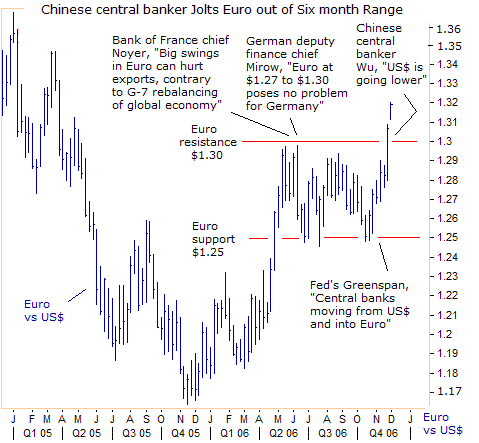
Central banks are key players in the currency markets, and traders are always on the lookout for signals that the heavy hitters are diversifying their FX reserves away from the world’s reserve currency, the US dollar. Global central bank reserves have more than doubled to $4.9 trillion in just three years, with particular focus on the massive US dollar stockpiles built up by Asian central banks, which could be switched into other currencies such as the Euro, Japanese yen, British pound, or Gold.
China’s FX reserves are on track to hit $1.5 trillion in the second quarter of 2008, and might hit $2 trillion by the end of 2010. China’s holdings of US Treasuries have skyrocketed from $59.5 billion to $342 billion since January 2001, and have kept interest rates artificially low in the face of large federal budget deficits. So the slightest hint of a bearish Chinese disposition towards the US dollar instantly sent the Euro spiraling above the psychological $1.30 level last week.

US Democrats on the Joint Economic Committee argued on Nov 4th, that “the United States must reduce its heavy dependence on foreign borrowing in order to avoid a run on the dollar and a steep rise in interest rates. Even without a run on the dollar, the need to pay interest of $100 billion or more per year on foreign holdings of Treasury securities will reduce US national income.”
“Our reliance on China and other nations to finance our debt is the result of a deliberate policy by the Bush administration, one that reversed course from the Clinton administration, and has favored deficit financing of tax cuts and federal spending over a prudent fiscal policy. It will take years of sound fiscal policy to reduce our reliance on foreign lenders and return the federal debt to a prudent level,” the Congressional Democrats concluded.

The Bush administration grants Beijing free and unfettered access to US consumer markets, in return for massive Chinese purchases of US bonds. But since Beijing decoupled the yuan from the rigid peg of 8.27 /US$, the yuan has appreciated by 5.6% to 7.835 per US dollar. That’s translated into a 10% loss for Beijing’s holdings of 10-year US Treasury notes when converted back into Chinese yuan.
During the same time, the price of Gold gained 40% against the Chinese yuan. “We have had a very clear diversification plan,” said Chinese central bank chief Zhou Xiaochuan on Nov 9th. “We are considering lots of instruments for diversification, including currencies, investment instruments, and emerging markets.” Asked if diversification included gold, Zhou coyly replied, “That’s a separate thing.”
Forward traders in Hong Kong predict the dollar will fall another 4% to 7.53 yuan within the next 12-months. US Treasury chief Henry Paulson and Federal Reserve chief Ben Bernanke will meet with Chinese officials on Dec 14-15th in Beijing. The yuan had its largest monthly gain in September, when Paulson held talks in Beijing with President Hu Jintao and Premier Wen Jiabao.
“There has been a fair amount of tension in the economic relationship,'” said Paulson at a business conference in London on Nov 27th. “For this to be successful, issues such as greater currency flexibility must be addressed,” he said. Ahead of the December meeting, traders think Beijing might allow the dollar to fall 0.5% to 7.80 yuan, to equal the Hong Kong dollar’s peg against the US dollar.
Korean Experience with US T-Notes
Interestingly enough, the December 14th meeting in Beijing would be exactly one year since PBoC chief economist Yu Yongding called for East Asian central banks to come up with a plan to slow the rate of accumulation of US dollars and eventually cut their holdings. “Asian countries don’t need more than $2 trillion of foreign exchange reserves, and dangerously exposed to a decline in the dollar.”
Yu said China faced big losses on its reserves if the US dollar does decline by as much as 30 percent. “That is a very big problem and I think the Chinese government should take some action to reduce the growth rate of the accumulation of foreign exchange reserves as we’re still facing the possibility of a big devaluation of the US dollar, so capital loss will be huge,” Yu warned.
“China's economy would take a big hit if the US dollar weakened sharply due to such factors as a bursting of the US property bubble. The loss for China’s foreign exchange reserves would be extremely serious. If that happens, it will be a tremendous hit to the Chinese economy,” he said. Yet Chinese leaders were slow to accept Yu’s advice and didn’t see the light until a few weeks ago.
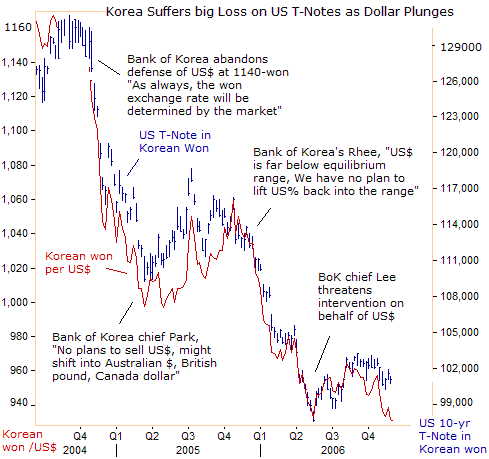
China faces a much graver situation than the Bank of Korea, which abandoned its defense of the US dollar at 1140-won two years ago. In Korean won terms, US Treasury 10-year notes have since plunged 22% lower, with the dollar falling to 930-won. Soon after the dollar collapsed from 1140-won towards the psychological 1000-won level in February 2005, the BoK said it would not sell US bonds outright, but instead, would diversify future reserve accumulation into high yielding currencies such as Australian and Canadian dollars, and the British pound.
Yet despite the Korean won’s 20% appreciation against the US$ from two years ago, Korean exports hit a record $30 billion in September ’06, or 22% higher than a year earlier. In the first nine months of 2006, Korean exports gained 14.9% year-on-year to US$238.62 billion. Bilateral trade between China and Korea was $61.9 billion last year, up 24% from the previous year, as Seoul started to wean itself off the US market.
Needless to say, traders will closely scrutinize the monthly reports on foreign purchases of US Treasury securities, to see if China is shying away from the depreciating US dollar, and instead, following the example of the Bank of Korea. That might account for the urgency of next month’s meeting in Beijing, especially with Democrats preparing a protectionist plan in Congress.
Underpinnings of US dollar remain weak
After the 3-year bear market for the US Dollar Index, which shaved a third of its value by December 2004, there was cautious optimism among FX traders that the greenback had finally bottomed out. In 2005, the US dollar began a counter-trend rally, recovering a third of its 2002-04 losses, under a wave of slow but steady rate hikes by the Federal Reserve to as high as 5.25 percent. Yet despite the Fed’s best efforts to rescue the dollar, the underpinnings of the US currency stayed weak.
Since December 2001, the monthly US trade deficit has increased $37.7 billion, saddling its economy with huge foreign debts and taxing domestic growth. In the third quarter, the trade deficit subtracted 0.6% from GDP growth. American economic output would be 20% greater today, were it not for the trade deficits accumulated over the past twenty years.
Despite the sharp devaluation of the US$ Index, the US trade deficit hit a record high of $69 billion in August. Three major segments account for the 90% of the US trade deficit Energy, automobiles, and Chinese and Japanese imports. On Nov 14th, General Motors CEO Rick Wagoner said Detroit automakers share a “strong conviction that the Japanese yen is systematically undervalued, which helps them to maintain significant trade balance surpluses in our industry.” Diplomatic efforts to persuade China to stop manipulating the yuan for the past 5-years were a sham.
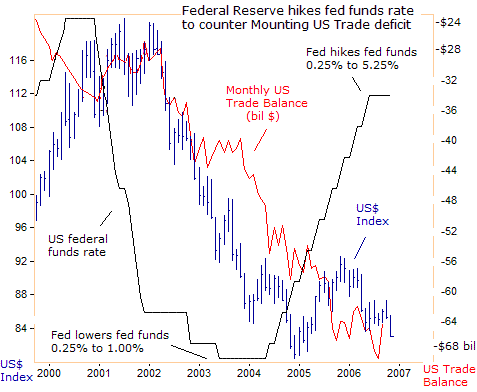
Energy imports have increased $17.1 billion per month since 2001, with the average price of imported oil soaring from $15.46 to $62.52 per barrel, and monthly imports increased 352 to 414 million barrels. Automobiles and parts account for $10.7 billion of the monthly trade deficit. Japanese and Korean manufacturers have snatched market share from GM and Ford by offering more attractive and reliable vehicles.
The US trade deficit with China was $23.0 billion in October, and has increased $17.5 billion per month since December 2001. Imports from China increased to a record $27.6 billion in September, but US exports to the Asian nation fell to $4.6 billion. China will soon replace Mexico as America’s second-largest trading partner behind Canada. So far this year, the value of trade between China and the US is $246.7 billion. That compares with $248.3 billion in trade with Mexico.
Fed Rates hikes trumped by Foreign Central Bank sales of US$
Fed rate hikes began to lose their potency to support a US dollar rally after Fed chief Ben Bernanke indicated on March 21st, that he wouldn’t lose any sleep over a weaker dollar. "Although US trade deficits cannot continue to widen forever, these deficits need not engender a precipitous decline in the dollar, nor should such a decline, were it to occur, necessarily disrupt financial markets, production or employment.”
While Bernanke’s comments were greasing the skids under the US dollar, it was Russian finance minister Alexel Kudrin, speaking to the annual IMF meeting in Washington on April 20th, dealt the hammer blow to the US$. “Russia cannot consider the US dollar as a reliable reserve currency because of its instability. This currency has devalued by 40% against the Euro in recent years. The international community can hardly be satisfied with this instability,” Kudrin said.

Kudrin touched a raw nerve among FX traders, and knocked the US$ Index about 6.6% lower over the next four weeks, until European finance ministers began to voice their displeasure with a Euro above $1.30. Two months later, Russia revealed that it had reduced its US$ exposure by 20% to 50% of its foreign exchange reserve, while boosting the Euro to 40% from 25% earlier.
Then on June 8th, the Russian Trading System launched futures contracts in gold and Urals crude oil denominated in Russian rubles instead of US dollars. Record oil prices have boosted Russia’s foreign exchange holdings by 54% to $279.8 billion, so that the Kremlin’s reserves are outstripped only by those of China and Japan.
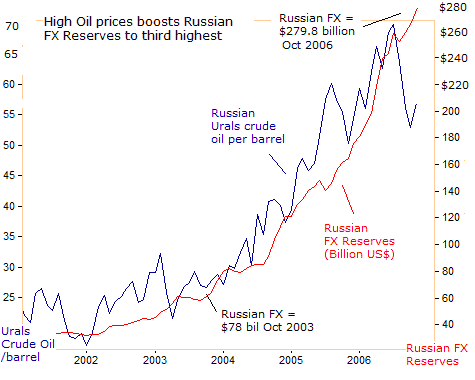
On October 16th, Alexei Ulyukayev, the Russian central bank’s first deputy chairman, said the Japanese yen would be increased as a proportion of the total reserves in 2007, and Russia would build stocks of other currencies, including the Australian and Canadian dollars. Izvestia newspaper reported on Nov 6th that Russia’s central bank bought six tons of gold in October to boost its reserves to 400 tons.
Italy’s central bank slashed its US dollar reserves to 63% from 84% in the first half of 2006, while holdings of sterling rose to 25% from zero in 2004. Italy’s official reserves equal 61.2 billion euros ($79 billion). Britain’s Daily Telegraph newspaper said the Bank of Italy was acting in advance of an expected slide in the dollar, once the Federal Reserve ended its two-year credit tightening campaign, leading traders to focus again on the gaping US current account and trade deficit.
As recently as November 7th, San Francisco Fed chief Janet Yellen warned, “many Asian and OPEC countries have a global savings glut and are holding US dollars to protect their economy from volatile capital flows such as the Asian currency crisis. There is a mutuality of interest. That doesn’t mean that it won’t change. It could be that countries will decide to channel less of it into dollar assets and that could have some impact at some stage,” she said.
Is the Federal Reserve out of Rate Hike Ammunition?
So far this year, the US dollar has shed over 10% of its value against the Euro, 12% against the British pound and 6% versus the Australian dollar. The Euro’s surge above $1.30 on November 24th unfolded 3-½ months after the Federal Reserve signaled a pause in its 2-year rate hike campaign at 5.25%. If the ECB decides to extend its tightening campaign beyond the widely telegraphed rate hike to 3.50% on December 7th, does the Federal Reserve have enough elbow room to match the ECB with a surprise quarter-point hike in the fed funds rate to 5.50% next year?
“Taking all of the factors on growth and inflation into account, my current assessment is that the risk of inflation remaining too high is greater than the risk of growth being too low,” said Chicago Fed chief Michael Moskow on Nov 7th. “Thus, some additional firming of policy may yet be necessary to bring inflation back to a range consistent with price stability in a reasonable period of time,” Moskow warned. The Chicago Fed chief added that “although crude oil prices have fallen, the potential for another price shock remains a risk to the US economy,” he said.
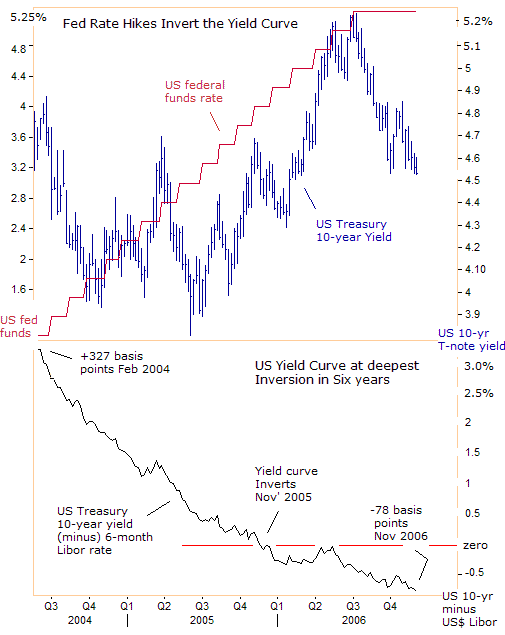
Moskow will join the Fed’s other leading hawk, Jeffrey Lacker, on the Fed’s voting committee in January, in supporting a tougher Fed policy. Also, recognizing the risk of higher inflation from a weaker US dollar, Philly Fed chief Charles Plosser called for higher rates on Nov 27th. “There remains some risk that policy is not yet firm enough to ensure a return to price stability over a reasonable time horizon.”
“We need to remain vigilant and recognize that maintaining the current stance of policy, or even firming further, may be in the best interests of the economy's long-run performance,” Plosser argued. Still, the consensus of opinion in the US Treasury bond markets and among foreign currency traders is that the Fed’s next move on interest rates is towards an easing of policy in 2007.
Since the Fed’s last rate hike to 5.25% on June 29th, the yield on the 10-year T-note has declined by nearly 70 basis points, producing a deeply inverted yield curve. At last reading, the yield on the 10-year note is roughly 78 basis points below the US$ six-month Libor rate, it’s deepest inversion since 2000, when bond traders correctly forecasted a US economic recession that materialized in 2002.
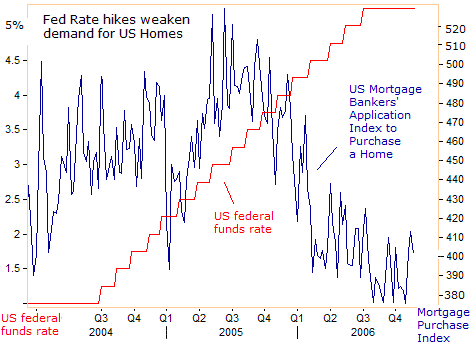
US home prices were 3.5% weaker in November than a year earlier, which is expected to persuade the majority of the Fed’s interest rate setting committee to hold rates steady at 5.25% thru January. The Mortgage Bankers Association’s Index for US home purchases, a real time indicator for the state of the US housing sector, fell to 401.4 last week, roughly 24% below its all-time high in Q’2 of 2005.
The pace of US home construction sank 14.6% in October, as a glut of unsold homes kept builders at bay, hinting economic growth will remain tepid and keeping hopes alive for interest-rate cuts. The annual pace of US housing starts was 1.486 million, the lowest level in more than 6-years, and 27.4% lower from October of last year. The Fed is counting on a limited economic slowdown to help keep inflation in check, but is keeping a careful eye on home prices.
Interest rate differentials undermining US dollar
Making matters worse for the US dollar is a sharp drop in interest rate differentials with Euro yields, one of the key factors propping up the dollar for the past two years. The gap between US Treasury’s 2-year Note and the German 2-year note is near an 18 month low, hovering at 108 basis points this week, and down from 180 basis points in mid June, just before the Fed’s last rate hike to 5.25%.
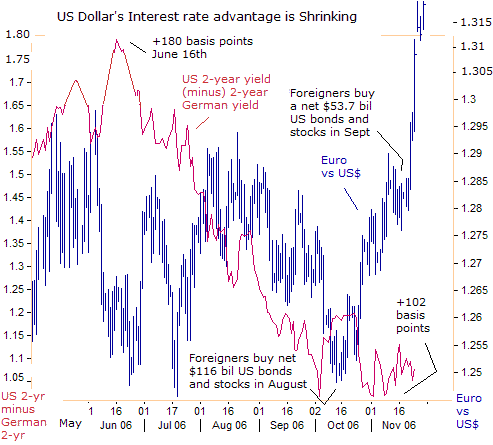
While the US Treasury bond market is pricing in a Fed rate cut, the benchmark German bund market is pricing in future ECB rate hikes. Yet it is interesting to note, the US dollar’s interest rare advantage was shrinking from a high of 180 bp in mid-June to as low as 102 bp on October 4th, but the Euro was pinned near $1.25 in mid-October, acting oblivious to the big shift in interest rate differentials.
Ironically, the Euro bottomed at $1.25 on October 17th, when the US Treasury reported that the foreign demand for US bonds and stocks soared to a record $116 billion in August, compared to only $32.9 billion in July. Thus, the US dollar topped out a very bullish news, then headed south over the next five weeks, as the arcane foreign exchange market decided to look at shrinking interest rate differentials.
Arab Oil kingdoms suffer FX losses on US$ Bonds
The foreign exchange market was also guided by statements from former Fed chief “Easy” Al Greenspan, who indicated on October 26th, “We’re beginning to see some move from the dollar to the Euro, both from the private sector and from monetary authorities and central banks. We’ll get to the point at some point that willingness to finance the current account deficit will slow,” Greenspan warned.
Greenspan was proven correct on Nov 16th, when the US Treasury said foreigners had scaled down their purchases of US bonds and stocks by 45% in September to $53.7 billion, falling short of the $64.4 billion US trade deficit for that month. Japanese bond traders were net sellers of $5.1 billion of US Treasuries, but Beijing was a net buyer of $3 billion and allowed the dollar to fall 1.5% to 7.84 yuan.

Arab oil kingdoms were net buyers of as much as $6.9 billion thru their brokers in London in September, after adding $11.1 billion to their portfolios in August. Arab oil kingdoms are recycling part of their petrodollar surplus into US Treasury bonds, to help finance the American war effort in Iraq, which costs about $2 billion per week. But the British pound has been a stronger currency than the Euro against the US dollar recently, dealing a bigger blow to Arab holdings of US bonds.
But United Arab Emirates central bank chief Sultan Nasser al-Suweidi is avoiding the US Treasury market, “I expect the Euro to become the currency of international trade and investment in 10 years. If we add tourism, the Euro will surpass the dollar as the first currency in the world by 2015.” The UAE central bank is shifting 10% of its $25 billion reserves out of the dollar and largely into British pounds and Euros.
European Central Bank Signals higher rates ahead
The ECB had already raised its key repo lending rate by 125 basis points since last December and has telegraphed a further 25 bps increase to 3.5% for December 7th. When asked asked about the rate outlook beyond that, Greek central banker Nicholas Garganas said on Nov 7th, “No matter what criteria one uses to characterize monetary conditions, the conclusion is inescapable that there is more than ample liquidity. Despite the interest rate increases to date, real rates remain through the whole maturity spectrum near historically low levels,” he said.
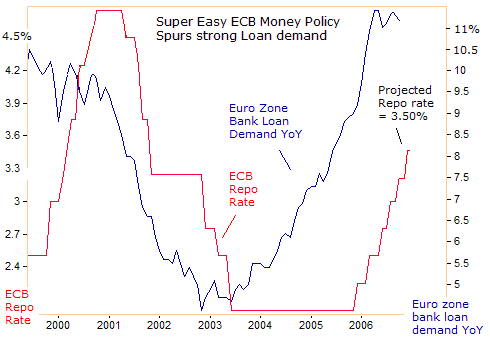
“There is little doubt to have further withdrawal of monetary accommodation. Moreover inflationary risks remain on the upside. If one looks at what is happening to producer prices, and non-energy related prices, the picture is one of elevated prices for goods. I think this is a clear indication of significant inflationary pressures remaining in the system,” Garangas said.
The Euro zone’s M3 money supply expanded at an annualized rate of 8.5% in October for the second month in a row, far above the ECB’s original 4.5% target. While total Euro zone bank lending growth eased 0.2% to 11.2% in October, loans to the corporate sector hit 12.9% annual growth rate in October, the highest since records began in 1998. Loans have increased in size, largely due to massive borrowing to finance $1.3 trillion of European mergers and acquisitions this year.

Futures traders in Frankfurt predict the ECB is on course to raise its repo rate by a quarter-point in the first quarter of 2007 to 3.75%. Meanwhile, traders in Chicago are betting on a 50% chance of a quarter-point Federal Reserve rate cut to 5.00 percent. That would narrow the US$’s rate advantage by 50 basis points and buoy the Euro above $1.300. However, due to the dollar’s structural weakness, any round of Fed rate cuts would be limited, so as to avoid a dollar free-fall into the abyss.
Bank of Japan battles Tokyo warlords over Interest rates
G-10 central bankers are calling on the Bank of Japan (BoJ) to tighten its monetary policy further, to discourage carry traders from borrowing yen, and reinvesting the funds in inflation assets around the world. European bankers object to unilateral ECB rate hikes without similar moves by the BoJ, which could exert further upward pressure on the Euro beyond 150-yen, already at 8-year highs.
The BOJ has left monetary policy unchanged after hiking its key overnight call rate target to 0.25% in July, the first rate hike in six years. Japan's economy grew an annualized 2.0% in the July-September quarter, double the pace the market was expecting and higher than the 1.6% growth in the United States in the same quarter. “I told the G-20 that the Japanese economy continues to expand steadily, amid stable prices. If this trend continues, we will adjust monetary policy gradually, looking at various risk factors ahead,” said BoJ chief Fukui.
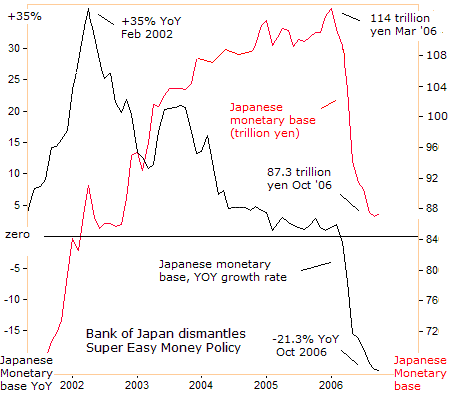
Japan’s monetary base in October was down 21.3% from a year earlier, marking the eighth consecutive month of decline. The monetary base has been falling on a year-on-year basis since March after the BOJ announced the end of its policy of flooding the banking system an excess of 26-trillion yen on March 9th. But despite the BoJ’s historic draining operation, the Japanese overnight loan rate remains at a paltry 0.25%, hardly reflective of the size of the world’s second largest economy.
Still, a top Japanese ruling party politician on Nov 7th, opposed a credit tightening by the BoJ, saying the economy had not yet emerged from deflation. “I believe Japan has yet to come out of deflation,” said Shoichi Nakagawa, the ruling Liberal Democratic Party policy chief. “I’m against the BOJ raising rates. Given the state of the Japanese economy, talking of a rate hike is absurd,” he said.
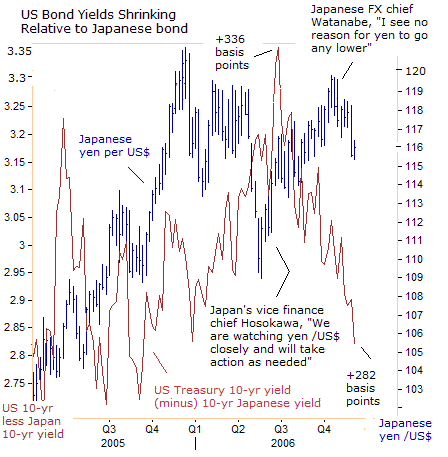
Tokyo financial warlords are closely watching the Bank of Japan, because a tighter monetary policy might cause, “Increases in long-term rates, which would have a big effect on the country's fiscal situation through the government’s debt interest payments,” said Japanese PM Shinzo Abe on October 4th. “We have to keep a close watch on their moves.” A 1% increase in 10-year bond yields would push up the debt-servicing costs by 1.6 trillion yen ($13.6 billion). Debt-servicing costs already account for a quarter of spending in the annual budget.
Japan had 765 trillion yen in sovereign marketable securities, or $6.5 trillion, outstanding at the end of June 2006, compared with $4.3 trillion in the US Treasury market. Since then, the spread between the US 10-year yield and the Japanese 10-year yield has narrowed 54 basis points to 2.82%, making US bonds less attractive to Japanese investors, and weighing on the dollar /yen.
Is “Stagflation” on the horizon for US Economy?
In the months ahead, the Federal Reserve could face the dreaded nightmare of “Stagflation.” Weaker home prices and a sinking US dollar on one hand, and rising gold prices on the other hand. Fed chief Bernanke observed on Nov 27th, “In the case of inflation, the risks to the forecast seem primarily to the upside. A failure of inflation to moderate as expected would be especially troublesome.”
Subscribers will also receive Email Alerts, sent out in-between regular newsletter postings, when important information unfolds in the global markets.
A subscription to Global Money Trends is $125 US dollars per year for 24 issues, including access to all back issues. Click on the following hyperlink, to order now, http://www.sirchartsalot.com/newsletters.php
© 2005-2022 http://www.MarketOracle.co.uk - The Market Oracle is a FREE Daily Financial Markets Analysis & Forecasting online publication.


